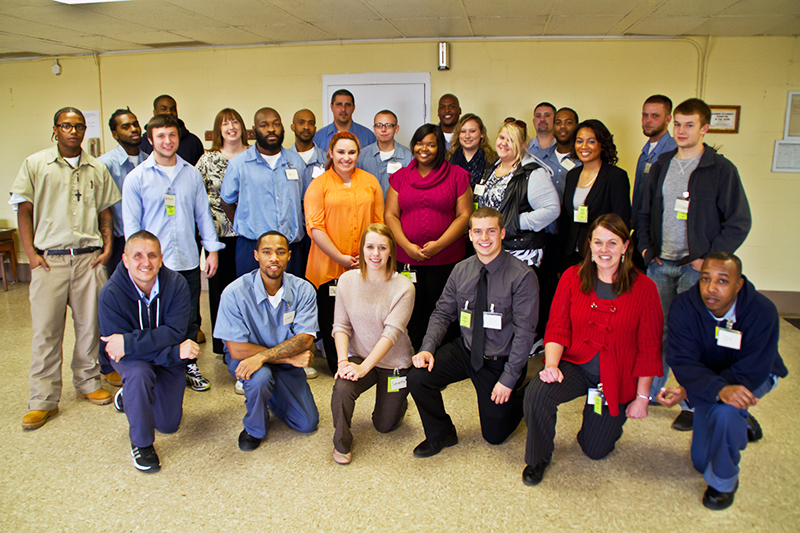
Ohio State students and student prisoners at Southeastern Correctional Complex at the closing ceremony of an Autumn 2013 sociology course. Credit: Courtesy of Angela Bryant
A group of Ohio State students will find themselves behind prison walls this semester.
OSU’s Inside-Out course, a sociology class on the American criminal justice system, is being offered for the seventh time.
The students of OSU’s Inside-Out course are set to visit the Southeastern Correctional Complex to attend a weekly class with prisoners who are serving time at the facility.
For three hours, OSU students get a feel for prison, while the prisoners get to be called by their name instead of number, sit in a circle with their new classmates and think and talk like typical college students.
This is the seventh year Angela Bryant, an assistant professor of sociology at OSU’s Newark campus, has taught the class inside the correctional institution in Lancaster, Ohio, about a 45-minute drive from the OSU’s Columbus campus.
The course is part of a national initiative called the Inside-Out Prison Exchange Program. The goal is to transform how people think about crime and justice by promoting dialogue between students in and outside the prison, according to the program’s website.
Classes are composed of 10 to 15 “outside” OSU students and an equal number of prisoners, or “inside” students, who sit alternating in a circle, to discuss topics ranging from the history of prison to the cause and consequences of mass incarceration.
Caitlin Schwartz, a third-year in psychology, took the Inside-Out class in Autumn 2014. She said the first class in prison was terrifying for her and her OSU “outside” classmates, as most of them had never set foot in a prison.
“When we first walked in, the prisoners were all sitting there and looked up at once,” Schwartz said. “You could feel the tension.”
Schwartz said the biggest surprise for her in the very first class was how nervous the prisoners were before the class started and how quickly they moved from being intimidated to comfortable and welcoming, after conversations about their favorite movies and food.
“(When) you think of criminals, you think they are not going to care,” Schwartz said. “But, in fact, they were equally as nervous as we were. They were just very normal.”
Lorenzo Vasquez, who was incarcerated for 22 years and three months on murder charges, is a former “inside” student who took the class in 2013.
He said he was shocked when he learned the high odds of being imprisoned that is faced by people of color in the United States.
“These numbers show how badly we need to change,” Vasquez said.
Schwartz said that class discussion about why people commit crimes took a turn toward taking the responsibility away from offenders by blaming extrinsic factors such as stress or lack of education in low-income areas. But Schwartz said some inside students disagreed and said they knew what they were doing.
She said conversations helped outside students not only gain a critical perspective of the criminal justice system and related social issues, but also helped them to understand their inside peers in a way they didn’t before.
One time, Schwartz was offended by an inside student because he was talking about women being violent toward men in a “very derogatory” way during their group conversation.
“As much as I wanted to be offended by his statement, it made me think about how if this cognitive perception on women is something that he holds prior to being incarcerated, and how does being in an all-male prison for a long amount of time perpetuate that issue,” Schwartz said.
Riane Paige, a fourth-year in criminology who took the class in 2013, said she was less judgmental of prisoners after taking that class.
“I started to realize that everyone had a past and everyone’s past is different,” she said. “They are people just like us.”
After serving more than two decades behind bars, Vasquez was released in May and got a job in Cincinnati as a welder. He said he will continue his education and pursue a college degree in criminal justice.
“I want to help teenagers to make sure they don’t end up in a situation (like) I was in,” Vasquez said.
Schwartz said it is a dream of hers to be able to make a difference in the prison system.
“My goal is to help prisoners on a personal level because I truly struggle with the idea that there is anything I can do to help the big-picture problem,” Schwartz wrote in her class journal.
Bryant said she sees the Inside-Out program as a way to create potential change in the criminal-justice system.
“It kind of reignites my own journey for social change activism … I’m very, very proud of everything people are accomplishing beyond Inside-Out,” Bryant said.
Correction Oct 2: An earlier version of the story stated Riane Paige is a a fifth-year in criminology, when in fact she is a fourth-year in criminology.


